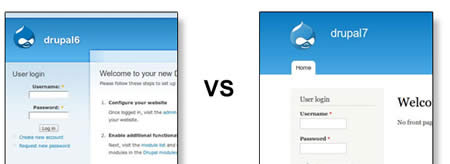Difference between Drupal 6 and Drupal 7
Key Difference: Drupal has many versions and is currently running on version 7. Each version aims at making the system more user-friendly and offers various different features that allow the websites to be more dynamic in nature. Drupal version 6 was introduced in February 2008, while Drupal version 7 was introduced in January 2011.
 Drupal is a content management framework or a CMS that allows users to build a website from the ground up without having to understand the programming language. However, Drupal is a bit complicated and does require extensive time to understand the workings of the system. It has a steeper learning curve, which means creating a website will take time. Drupal is best suited for complex or large-scale websites.
Drupal is a content management framework or a CMS that allows users to build a website from the ground up without having to understand the programming language. However, Drupal is a bit complicated and does require extensive time to understand the workings of the system. It has a steeper learning curve, which means creating a website will take time. Drupal is best suited for complex or large-scale websites.
Drupal is a free and open-source content management framework (CMF) that is written in PHP language. It is used for blogging websites as well as for political and government websites. Wikipedia states that the standard release of Drupal, known as Drupal core offers features such as “user account registration and maintenance, menu management, RSS feeds, page layout customization, and system administration.” It can be used as a brochureware website, a single- or multi-user blog, an Internet forum, or a community website providing for user-generated content. Drupal does not require any programming skills from a developer for basic installation and administration. Drupal was initially written by Dries Buytaert on a message board, which further became an open source project. Drupal is derived from Dutch word ‘druppel’, which means "drop".
Drupal has many versions and is currently running on version 7. Each version aims at making the system more user-friendly and offers various different features that allow the websites to be more dynamic in nature. Drupal version 6 was introduced in February 2008, while Drupal version 7 was introduced in January 2011. There is not set date for the release of the versions.
Drupal.org lists the changes made in version 7. The company lists all the changes in the version in the Drupal change log, which can be found on the website.
- Drupal 7 requires new system requires such as MySQL 5.0.15 or PostgreSQL 8.3, PHP Version 5.2 or higher and PHP Memory of 40M - 64M
- More secure implementation for scheduled tasks (cron.php)
- More secure password system
- More secure log-in system
- Modules can be updated via the web
- Administrative links to edit existing page elements on each page
- Improved support for integration of WYSIWYG editors
- More drag-and-drop for administrative tasks
- Permissions now have the ability to handle more meta-data
- User 1 created as part of the installation process
- Added features to the default install profile
- Automated task runs can be set up via configuration
- Redesigned password strength validator
- Renamed "input formats" to "text formats"
- Added support for default text formats to be assigned on a per-role basis
- Moved text format permissions to the main permissions page
- Added "vertical tabs"
- Improved time zone support
- Removed per-user themes
- Added new "Shortcuts" module
- Added query builders for INSERT, UPDATE, DELETE, MERGE, and SELECT queries
- Support for master/slave replication, transactions, multi-insert queries,delayed inserts, and other features
- Added support for the SQLite database engine
- Default to InnoDB engine, rather than MyISAM, on MySQL when available for greater scalability and data integrity
- Hook API documentation included in Drupal core
- Added OPML import functionality for RSS feeds
- Added feed update options
- Added support for language-aware searches
- Added test framework and tests
- Remove some themes and added other themes as default on user and admin interface
- Files are now first class Drupal objects with file_load(), file_save(), and file_validate() functions and corresponding hooks.
- Files use PHP stream wrappers to enable support for both public and private files and to support pluggable storage mechanisms and access to remote resources
- Added a field specifically for uploading files
- Improved image handling
- Added a field specifically for uploading images
- Better Support for Multisite Installations
- Added RDF support
- Better support for search engine optimization and web linking
- Added ability to add custom fields
- Installer can be run from the command line
- Upgrades made to core JavaScript library, JQuery Forms library
- Added jQuery UI 1.8
- Improved node access control system
- Improved handling of long-running tasks
Image Courtesy: accella.net









Add new comment